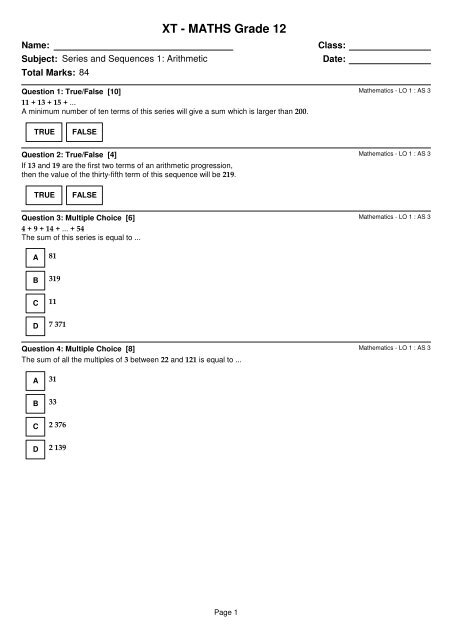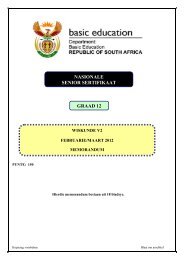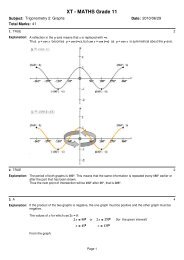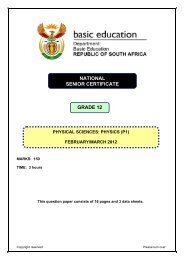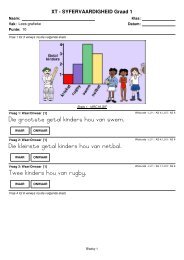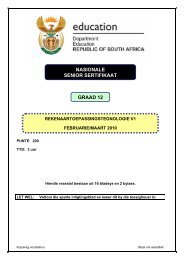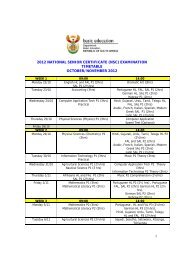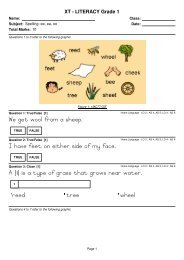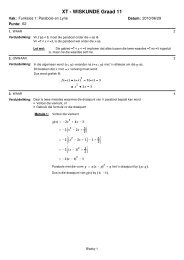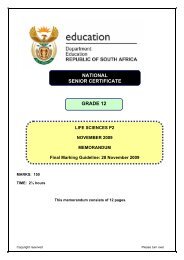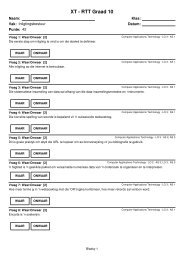XT - MATHS Grade 12
XT - MATHS Grade 12
XT - MATHS Grade 12
Create successful ePaper yourself
Turn your PDF publications into a flip-book with our unique Google optimized e-Paper software.
Name:<br />
Subject: Series and Sequences 1: Arithmetic<br />
Total Marks: 84<br />
<strong>XT</strong> - <strong>MATHS</strong> <strong>Grade</strong> <strong>12</strong><br />
Question 1: True/False [10]<br />
11 + 13 + 15 + ...<br />
A minimum number of ten terms of this series will give a sum which is larger than 200.<br />
TRUE FALSE<br />
Question 2: True/False [4]<br />
If 13 and 19 are the first two terms of an arithmetic progression,<br />
then the value of the thirty-fifth term of this sequence will be 219.<br />
TRUE FALSE<br />
Question 3: Multiple Choice [6]<br />
4 + 9 + 14 + ... + 54<br />
The sum of this series is equal to ...<br />
A 81<br />
B 319<br />
C 11<br />
D 7 371<br />
Question 4: Multiple Choice [8]<br />
The sum of all the multiples of 3 between 22 and <strong>12</strong>1 is equal to ...<br />
A 31<br />
B 33<br />
C 2 376<br />
D 2 139<br />
Page 1<br />
Class:<br />
Date:<br />
Mathematics - LO 1 : AS 3<br />
Mathematics - LO 1 : AS 3<br />
Mathematics - LO 1 : AS 3<br />
Mathematics - LO 1 : AS 3
Question 5: Multiple Choice [4]<br />
Which of the following progressions represent arithmetic sequences?<br />
A : 9 ; 7 ; 5 ; 3 ; ...<br />
B : 3 ; 9 ; 27 ; ...<br />
C : ( x + + 4) ; (3 x + + 3) ; (5 x +<br />
+ 2) ; ...<br />
A<br />
B<br />
C<br />
D<br />
A only<br />
B only<br />
C only<br />
A and C<br />
E A and B<br />
Question 6: Socrates [8]<br />
n<br />
∑<br />
If (2 k − − − 1) = = = 144,<br />
then n = =<br />
= ...<br />
k=<br />
1<br />
Type the number only.<br />
Question 7: Socrates [4]<br />
Given: 11 ; 6 ; 1 ; ...<br />
The sum of the first nineteen terms of this sequence will be equal to ...<br />
Type the number only.<br />
Question 8: Socrates [2]<br />
The arithmetic mean of 16 and 25 is ...<br />
Give your answer in decimal form.<br />
Page 2<br />
Mathematics - LO 1 : AS 3<br />
Mathematics - LO 1 : AS 3<br />
Mathematics - LO 1 : AS 3<br />
Mathematics - LO 1 : AS 3
Question 9: Cloze [6]<br />
Consider the recursive number pattern: Tn = Tn - 1 + Tn - 2, T1 = 1, T2 = 3<br />
The first six terms of this pattern are (ans 1).<br />
The number pattern (ans 2) an arithmetic pattern.<br />
The name of the particular pattern generated is the (ans 3) series.<br />
1 2<br />
3<br />
1, 3, 4, 7, 11, 18 4, 7, 11, 18, 29, 47 1, 3, 1, 3, 1, 3,<br />
is is not arithmetic<br />
Euclidean Lucas<br />
Question 10: Cloze [6]<br />
Consider the number pattern: -6, 2, 14, 30, 50, ...<br />
The next two terms in the sequence are (ans 1).<br />
This pattern has its second difference constant; thus it is a (ans 2) pattern.<br />
The recursive formula (ans 3) generates this number pattern.<br />
1 2<br />
3<br />
74, 102 74, 104 70, 92<br />
linear quadratic cubic<br />
Tn = Tn - 1 + 4n, T1 = - 6 Tn = 2n 2 + 2n - 10 Tn = 2Tn - 1 + 14, T1 = -6<br />
Question 11: Cloze [6]<br />
The sixth term of an arithmetic sequence is - 21 and the thirteenth term is 14.<br />
To calculate the value of d, two equations must be used simultaneously.<br />
These two simultaneous equations are a + 5d = - 21 and (Ans. 1).<br />
The value of d will then be equal to (Ans. 2) and the<br />
first term of this sequence will be (Ans. 3).<br />
1 2<br />
3<br />
- 35 5 a + <strong>12</strong>d = 14<br />
a + 13d = 14 -7 1<br />
-46 -26 14<br />
Question <strong>12</strong>: Socrates [3]<br />
− − 7 ; − − 4 ; −<br />
− 1 ; ...<br />
The n th term of this arithmetic sequence is given by Tn = ...<br />
Page 3<br />
Mathematics - LO 1 : AS 3<br />
Mathematics - LO 1 : AS 3<br />
Mathematics - LO 1 : AS 3<br />
Mathematics - LO 1 : AS 3
Question 13: Socrates [10]<br />
k<br />
The greatest value of k for which ∑ (2 t − − 3) <<br />
< 528 is ...<br />
t = 1<br />
Type the number only.<br />
Question 14: Multiple Choice [2]<br />
The n th term of a sequence is 3n - 2.<br />
The eighth term of this sequence will be equal to ...<br />
A 22<br />
B 3n - 2<br />
C<br />
D 2<br />
10<br />
3<br />
Question 15: Multiple Choice [5]<br />
3 ; x ; y ; 63 are the first four consecutive terms of an arithmetic sequence.<br />
The numerical values of x and y are ...<br />
A x = - 23 and y = 43<br />
B x = 23 and y = 43<br />
C x = - 43 and y = 23<br />
D x = - 23 and y = 43<br />
Page 4<br />
Mathematics - LO 1 : AS 3<br />
Mathematics - LO 1 : AS 3<br />
Mathematics - LO 1 : AS 3<br />
15 Questions, 4 Pages


